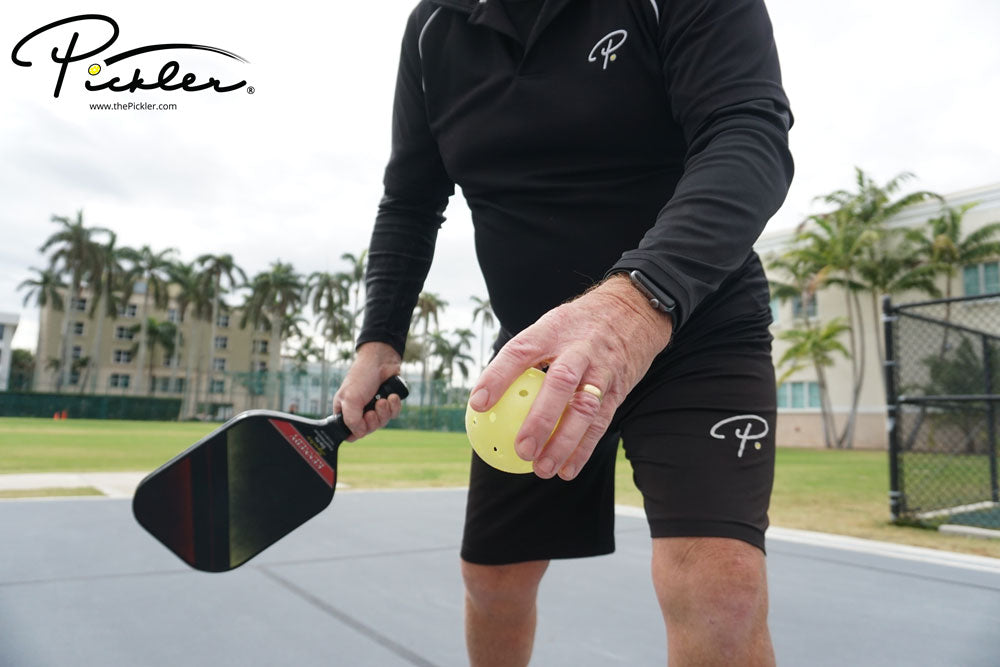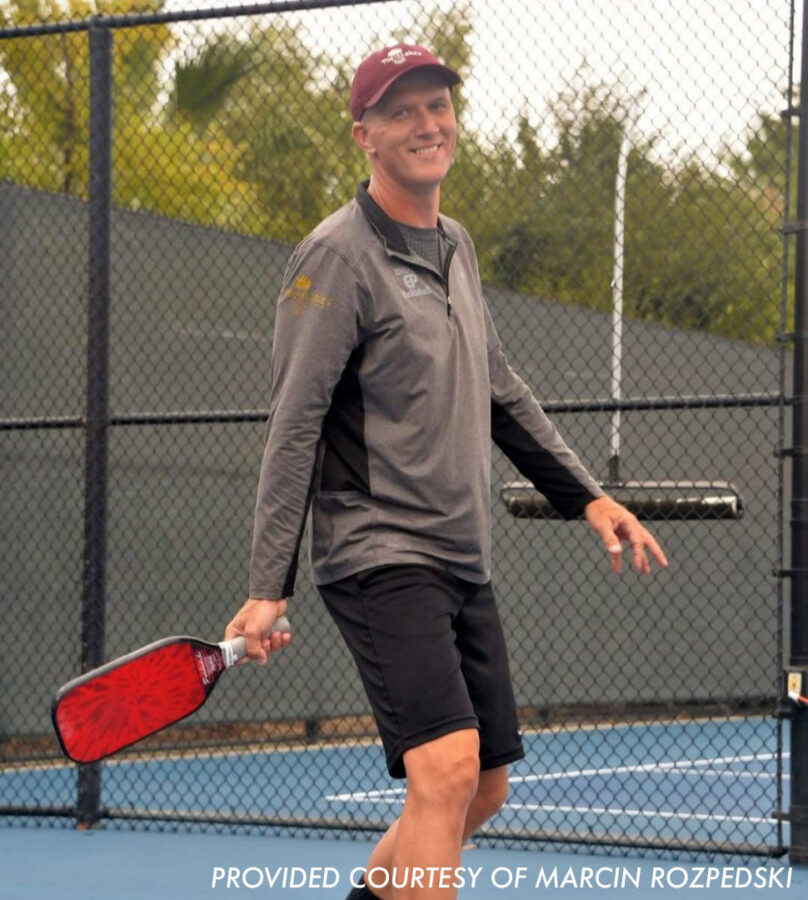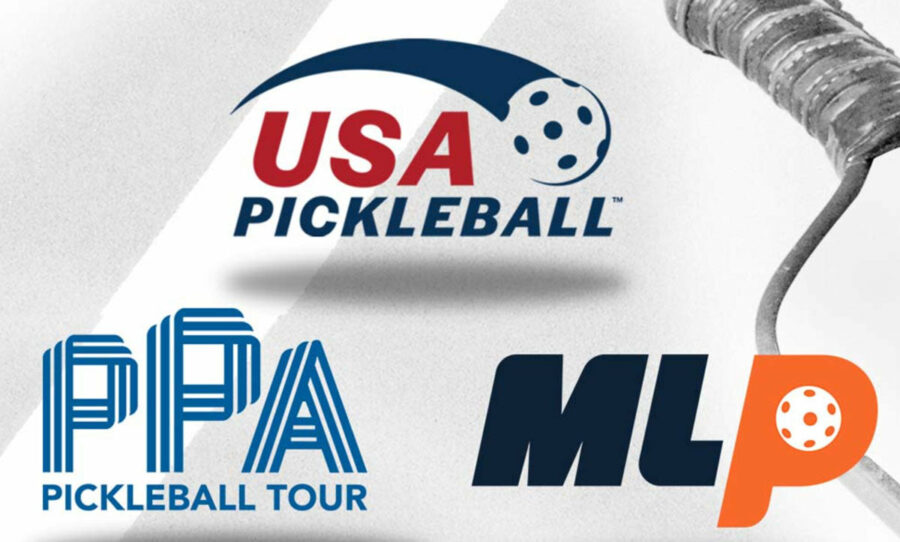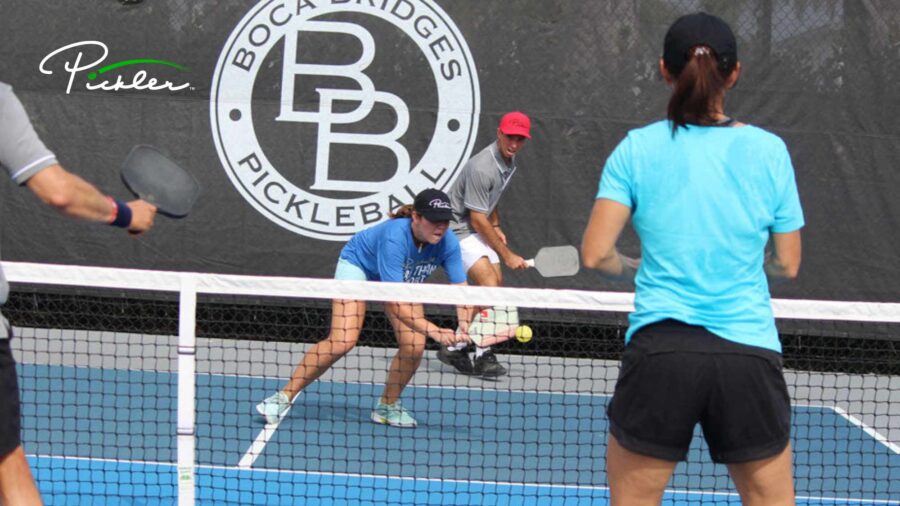3 Basic Pickleball Serving Rules
Every pickleball game, and every rally within a pickleball game, starts with a serve. Although there are many nuances to the serve in the sport of pickleball, there are three basic rules for the pickleball serve:
- Underhand Serve – Pickleball uses an underhand serve (unlike tennis, which has an overhand serve). The Official Rulebook for pickleball requires the serve to be hit below your navel (in other words, your belly button) with, at the point of contact:
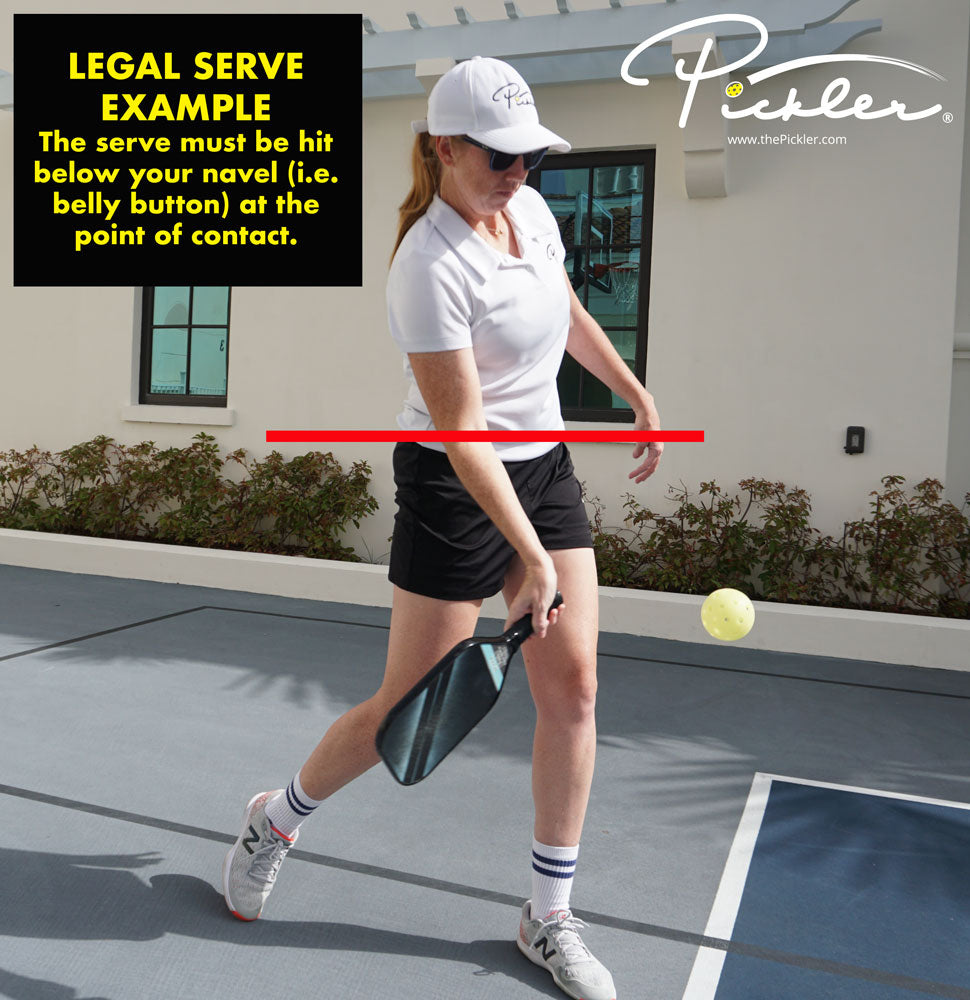
- your arm moving in an upward arc (to note, you may hit the serve with either a forehand or backhand motion); and
- the highest point of your paddle head being below the highest part of your wrist (which is the point on your wrist where your joint bends).
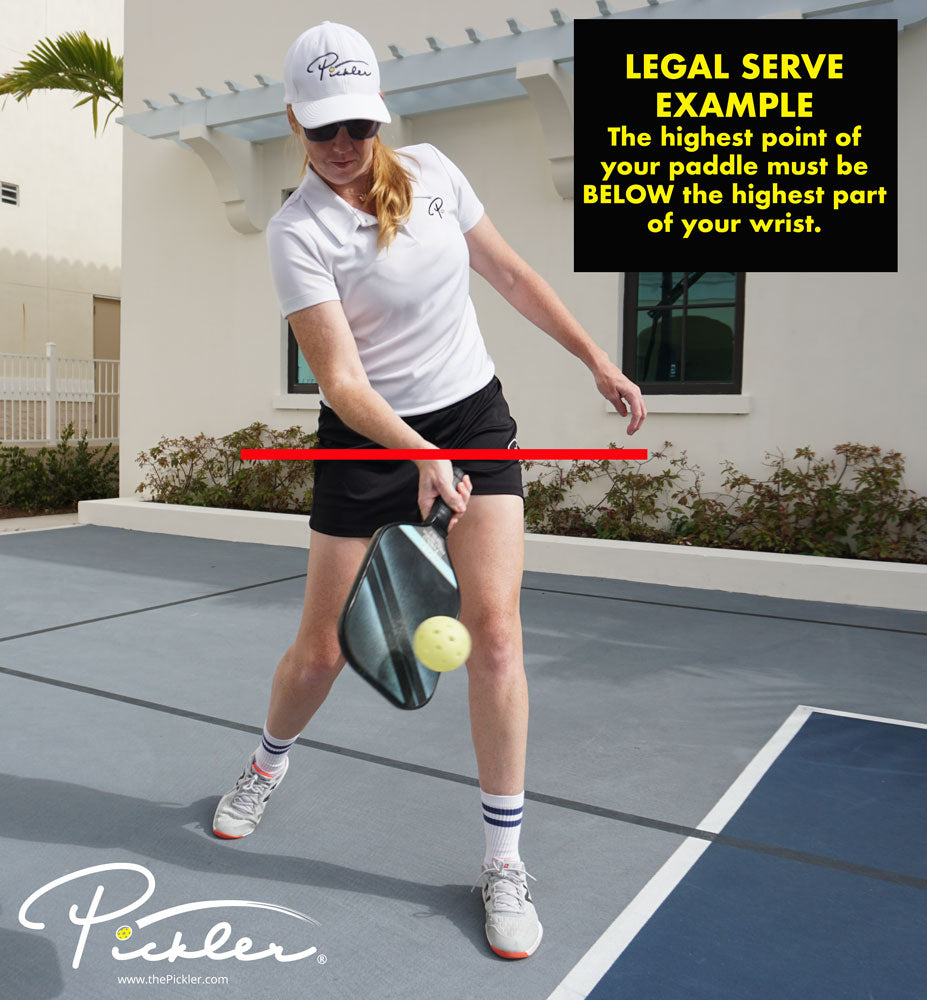

- Feet Placement – Your foot placement is important at the point of contact on your serve in pickleball. At the point of contact between your paddle and the pickleball on your serve, at least one foot must remain in contact with the ground behind the baseline. This means that you may not jump and serve at the same time – at least one foot must remain in contact with the ground behind the baseline.
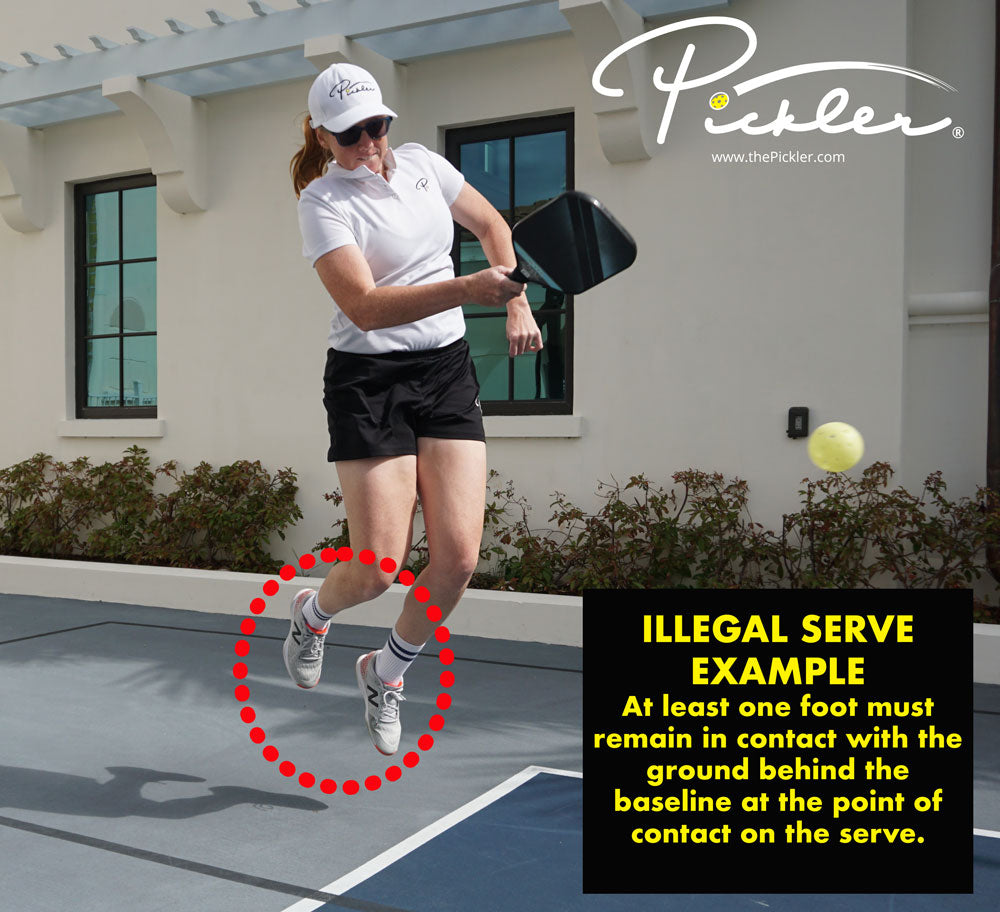
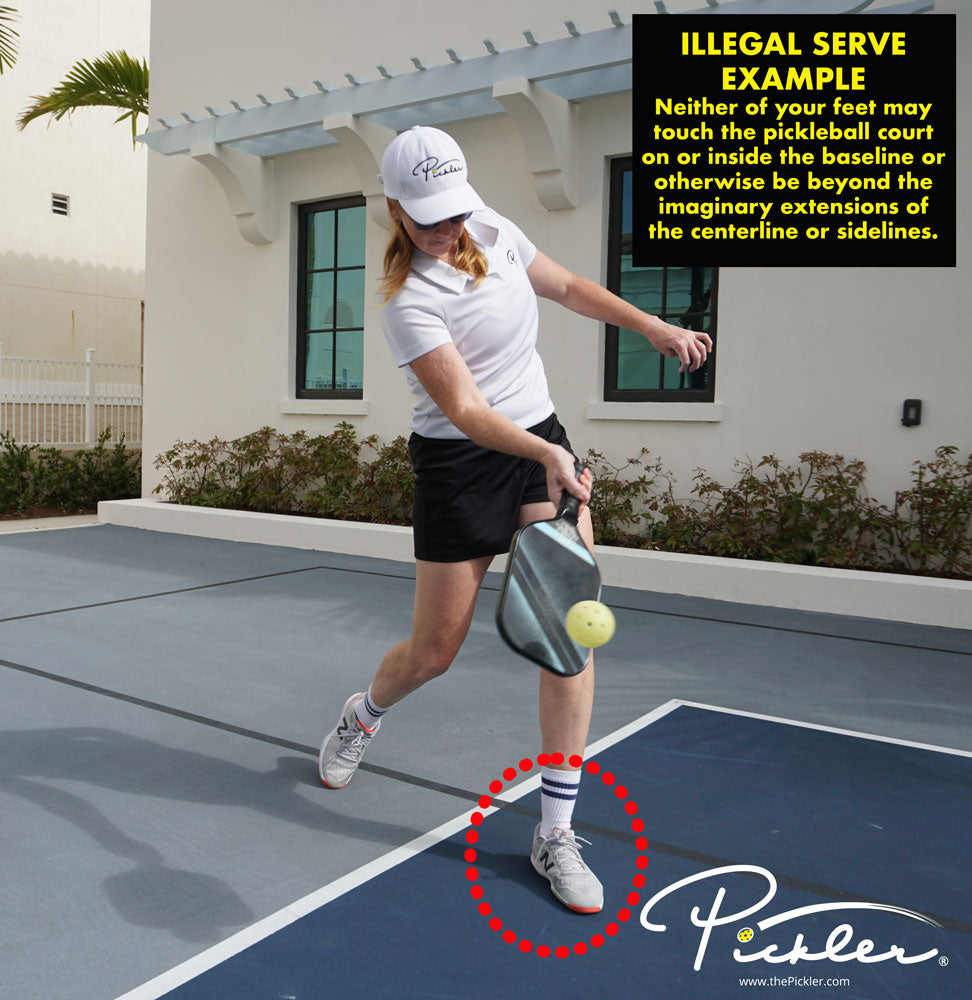
- Crosscourt Serve – The pickleball serve must go over the pickleball net (although the pickleball may touch the pickleball net – there are no service lets in the game of pickleball) and land in the service box that is crosscourt from the server. In other words, the serve must land in the area enclosed by the baseline, sideline, Non-Volley Zone line (also known as the Kitchen line), the centerline, that is diagonal from the server on the pickleball court.
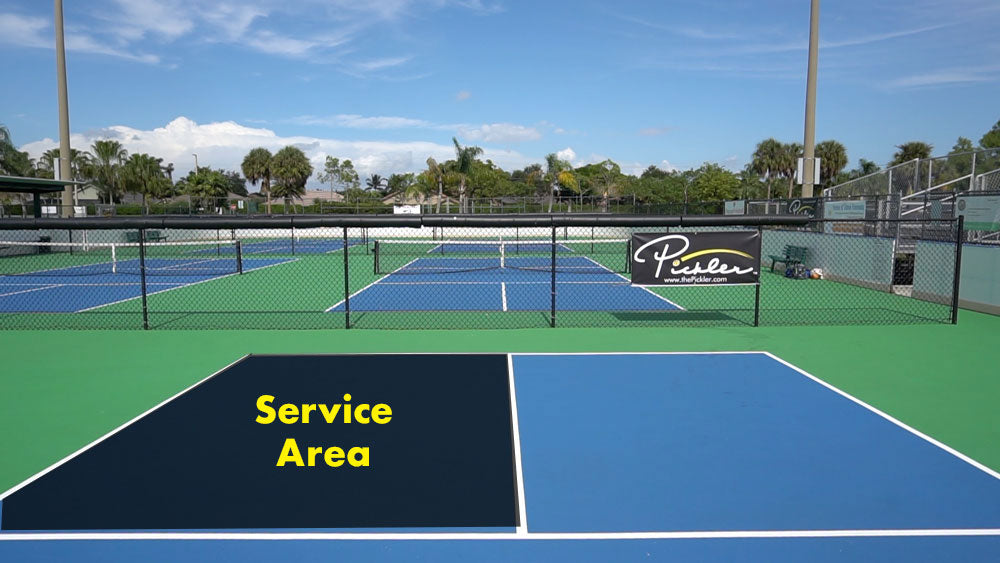
On the serve, the pickleball may not land in the Non-Volley Zone (also known as the Kitchen) or on the Non-Volley Zone line, as each of these scenarios would be considered a fault. However, the served pickleball may land on any other line – the baseline, sideline, or centerline.
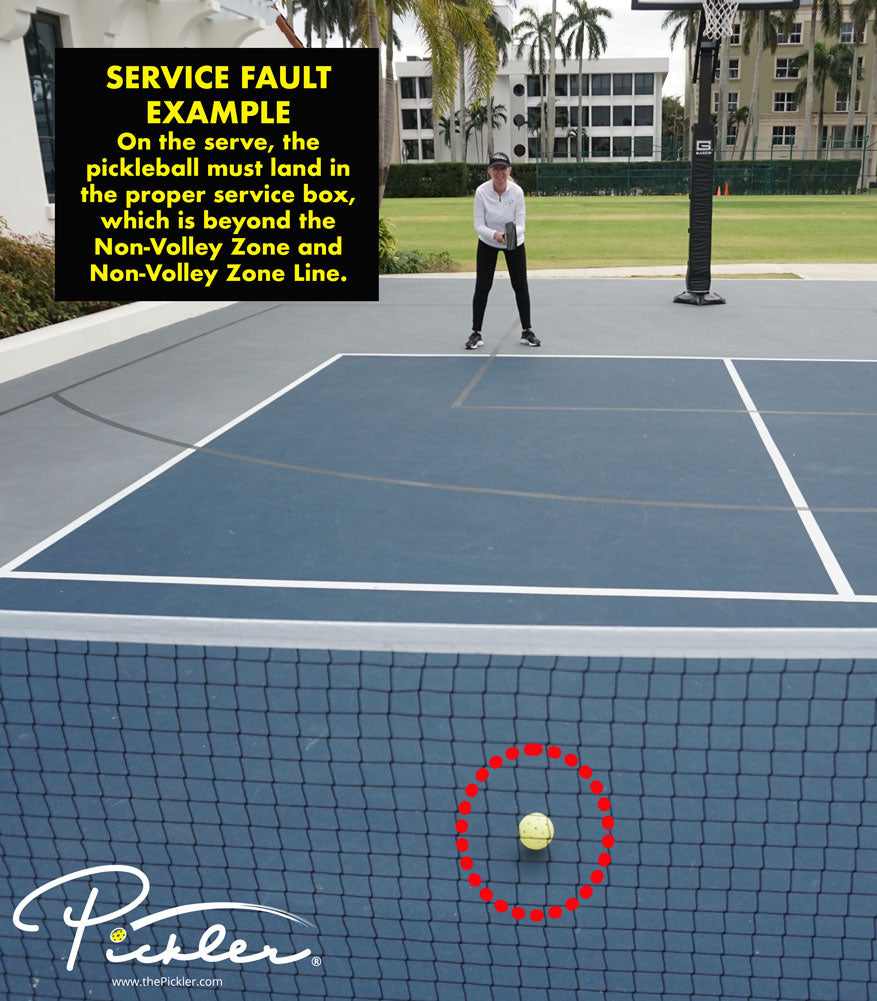
Be wary of violating these rules and committing an illegal serve on the pickleball court! For instance, striking the pickleball above your belly button, or with the head of your pickleball paddle above your wrist, will result in an illegal serve. If you violate these pickleball serve rules, then you will commit a fault and lose the rally and your serve.
Pickleball Volley Serve or Pickleball Drop Serve
There are two ways to the serve in pickleball. The first is a pickleball volley serve. To do a pickleball volley serve, you must toss or release the pickleball and then hit the pickleball with your paddle without allowing the pickleball to bounce on the court (in other words, volley the serve). This pickleball volley serve is the more traditional serving method on the pickleball court.
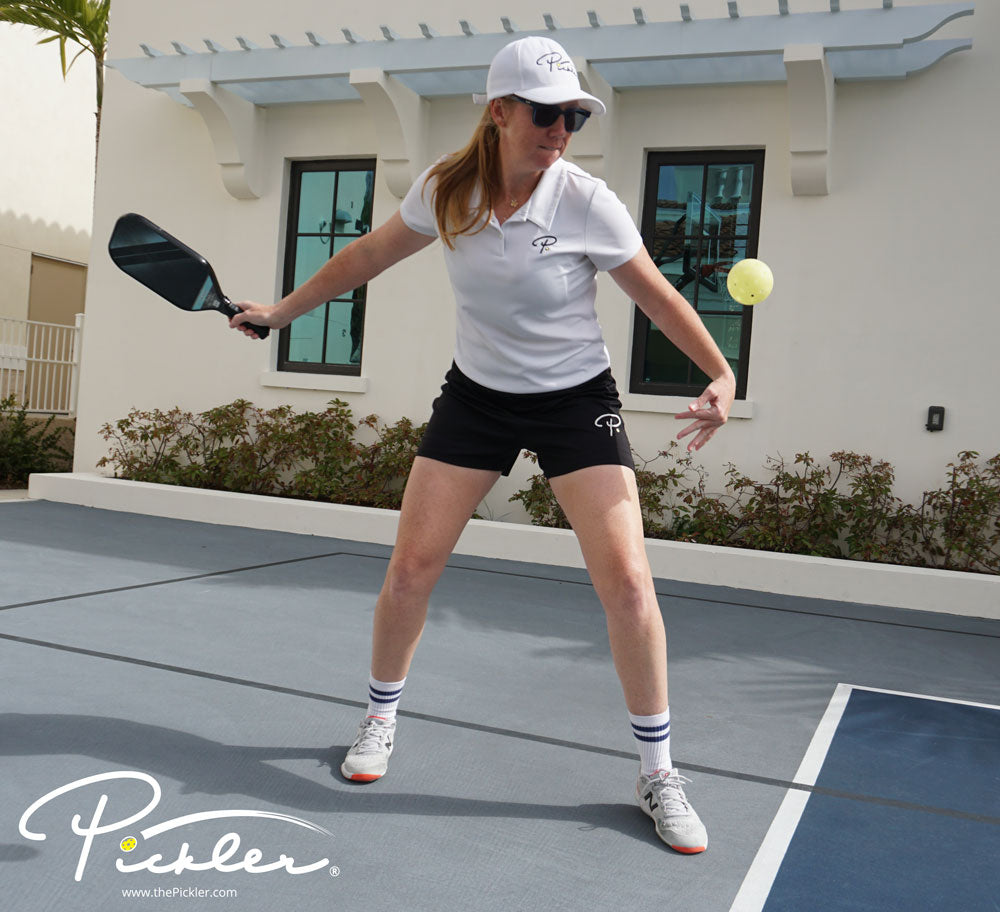
For the pickleball volley serve, consider the following tips for the toss:
- Try lifting the pickleball or tossing the pickleball into the air before striking the pickleball with your paddle. This will give you additional time and space to hit the pickleball, as well as allow you to hit the pickleball from a higher point of contact (as opposed to a lower point of contact around your knees).
- Do not hit any bad tosses. You have 10 seconds after the score has been called to hit your serve. As a result, if you have a bad toss, do not hit your serve. Pick the pickleball up and try the toss again.
- Practice your toss! To note, the rules regarding adding spin to your toss have been revised starting in 2023. Starting in 2023, no spin is permitted to be added to your toss on your serve.
The second way to serve the pickleball is an alternate serving method called a drop serve. The Official Rulebook for pickleball created the drop serve for players with a physical disability (for instance, any player with one arm). However, the pickleball drop serve is now available to all players, as the pickleball drop serve is also a “provisional rule” under the Official Rulebook, which means that the pickleball drop serve is currently permitted, but may be revised or removed in the future based on its effect on the sport. To do a pickleball drop serve, you must drop or release the pickleball from any natural height, either by using your hand or letting the pickleball roll off of your paddle, and then hit the pickleball with your paddle after the pickleball bounces on the court.
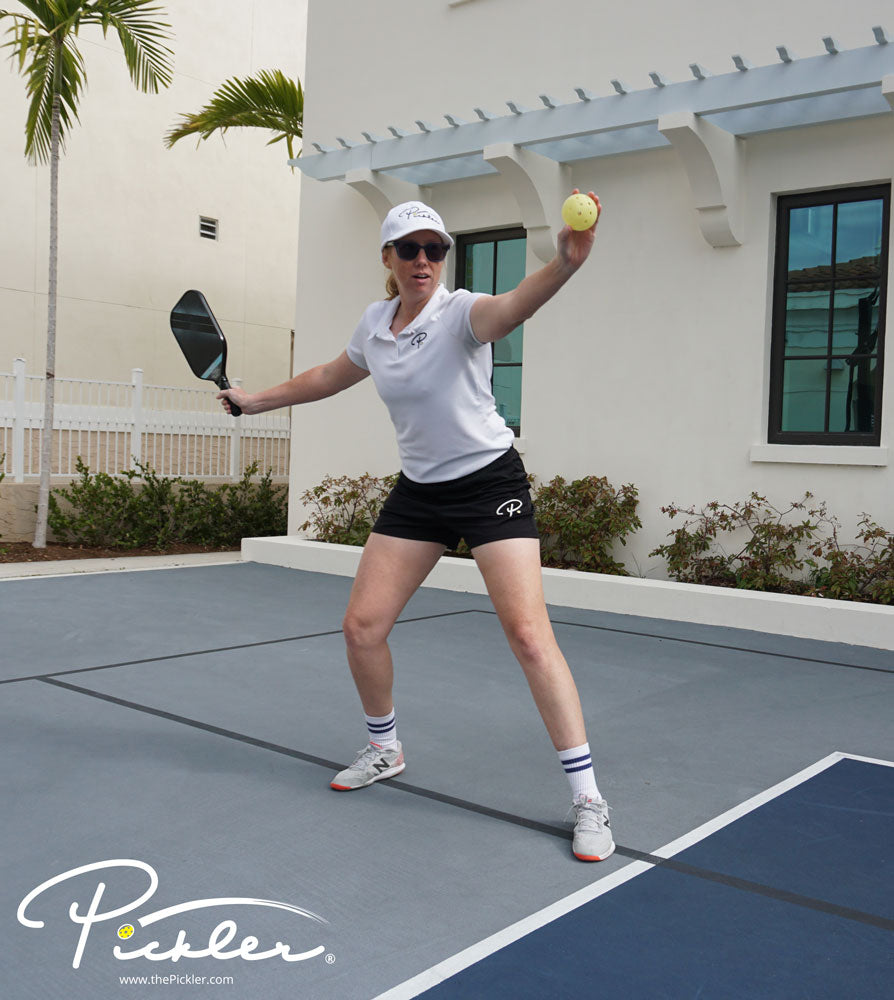
Under either the traditional pickleball volley serve or the new pickleball drop serve, many of the same pickleball rules apply. For instance:
- You may hit the pickleball with either a forehand or a backhand motion.
- The basics serving rules for feet placement apply. At the point of contact between your paddle and the pickleball on your serve (whether a pickleball volley serve or a pickleball drop serve), at least one foot must remain in contact with the ground behind the baseline. Neither of your feet may touch the pickleball court on or inside the baseline, or on or outside of the imaginary extension lines of the applicable sideline or centerline.
- The basic rules for location of the serve apply. Your serve (whether a pickleball volley serve or a pickleball drop serve) must land in the correct service court, which will be diagonal to the server.
- You must hit the pickleball within 10 seconds of the score being called.
However, if you hit a pickleball drop serve, then no other restrictions apply – for instance, the restrictions for hitting the pickleball below your navel, moving your arm in an upward arc, or keeping the highest point of your paddle head being below the highest part of your wrist. This is because, if done properly and in accordance with the rules, the pickleball drop serve will never bounce higher than your navel.
As a result, the pickleball drop serve could be hit with a lot of slice (in other words, backspin) or side spin, which is not a common result when hitting a traditional pickleball volley serve. A pickleball drop serve with fierce slice or side spin could result in a difficult return for the receiving team (including potentially short serves near the Non-Volley Zone line). A pickleball drop serve could also be hit with a lot of forehand top spin, which is also not a common result when hitting a traditional pickleball volley serve.
Pickleball Drop Serve – How to Do a Pickleball Drop Serve
The pickleball drop serve was originally included in the Official Rulebook for pickleball because it is a better serving method for players with a physical disability (for instance, any player with one arm). However, the pickleball drop serve has other benefits, too, which is why the drop serve has been included as a provisional rule in the Official Rulebook. These other benefits include that the drop serve may:
- be easier to teach beginners;
- give players with the “yips” or “server’s block” an alternative to overcome such “yips” or “server’s block”; and
- be easier for referees to enforce because referees only need to determine whether the player dropped the pickleball correctly.
To do a pickleball drop serve, you must drop or release the pickleball from any natural height, either by (a) using your hand or (b) letting the pickleball roll off of your paddle, and then hit the pickleball with your paddle after the pickleball bounces on the court.
There are quite a few pickleball rules to know when it comes to how to drop or release the pickleball on your drop serve:
- The height of the drop/release on your pickleball drop serve must be un-aided. This means you may not stand on a chair or your partner or otherwise jump to gain more height on your drop/release. Further, you may not throw or add downward force on the pickleball, toss up the pickleball, hit the pickleball up or down with your paddle, or add any acceleration to the drop/release of the pickleball. It must be a simple drop/release of the pickleball and only gravity may accelerate the pickleball toward the court.
- The drop/release of the pickleball on your serve must be visible to both the receiver and, if the game is officiated, the referee. If the pickleball is not visible to the receiver and/or referee at the time of the drop/release, then a replay must be called prior to the return of serve. Again, if the drop/release is not visible, a replay will result (rather than a fault and a loss of serve). Further, a replay is not called prior to the return of the serve, then the point plays on!
- If you fail to drop or release the pickleball in accordance with the pickleball serve rules (in other words, by aiding the pickleball by some force other than gravity, such as by throwing down or tossing up the pickleball), then you will have committed a fault and you will lose your serve.
- There is no restriction on how many times you may drop or release the pickleball. For instance, if you drop the pickleball and the pickleball takes a strange bounce, then simply catch the pickleball and re-drop. However, remember that you only have 10 seconds after calling the score to hit your serve. Further, once you make contact with the pickleball with your paddle, there are no more re-drops, re-releases, or other do-overs on your serve.
- There is also no restriction on where the pickleball may land on your drop or release for your drop serve. This means that your drop or release of the pickleball could land on the baseline, sideline, centerline, or even in the pickleball court, as long as you comply with the basic pickleball serve rules for foot placement.
- Lastly, if you are trying to use the pickleball drop serve, but the pickleball is just not cooperating with you and is taking strange bounces, you can always switch to the pickleball volley serve, or vice versa. However, remember that you only have 10 seconds after calling the score to hit your serve on the pickleball court.
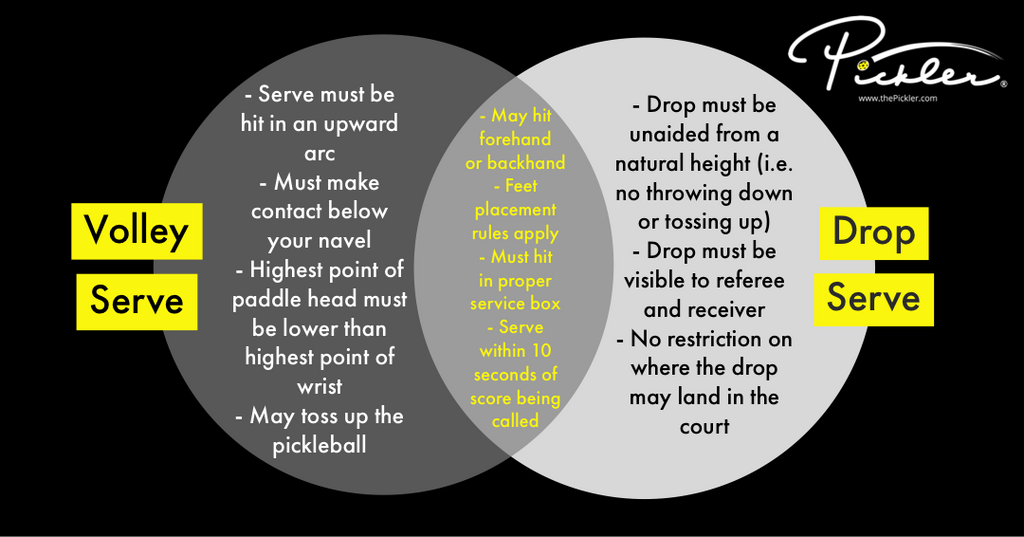
When to Serve the Pickleball
You may not serve the pickleball until the entire score is called (in other words, all three digits during doubles pickleball play, or both two digits during singles pickleball play). Stated another way, you may not make contact with the pickleball on your serve until the entire score is called – otherwise, you would have committed a fault.
However, once the score has been called (by either the server or the referee), then the server only has 10 seconds to serve the pickleball. This is true regardless of whether or not the receiving team is in the correct position or is ready to receive the serve (as a reminder, the score should not be called until the receiver is (or should be) in the correct position and the receiving team is (or should be) ready to play).
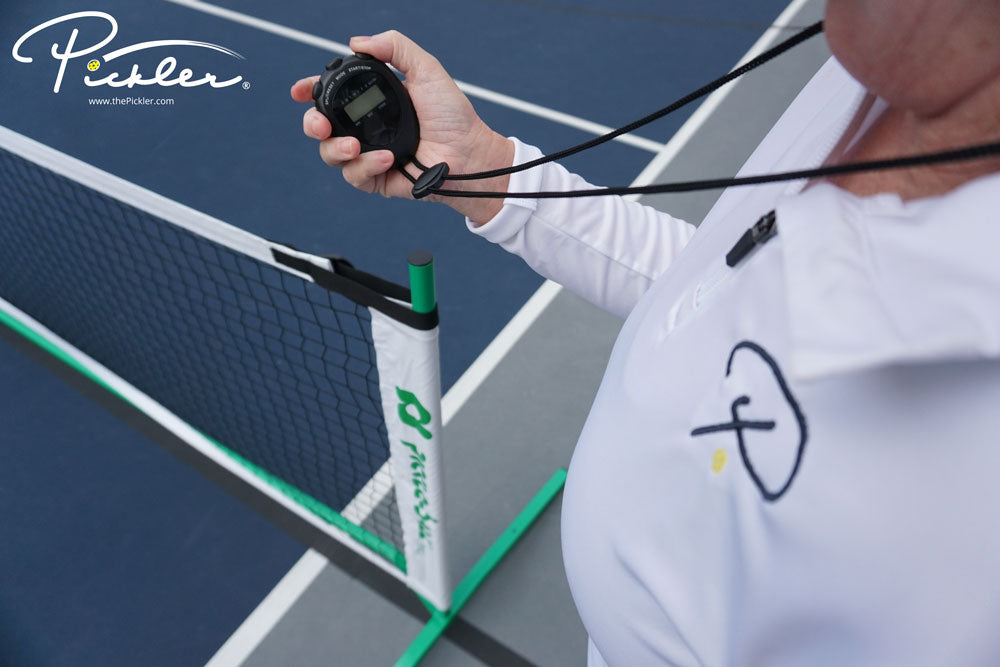
There is one exception to the 10-second rule. If, after the score is called, the serving team realizes that they are in the wrong position and changes their position on the pickleball court, then the serving team and/or referee must allow the receiving team time to re-position. The server, or referee if the match is officiated, will then re-call the score, and the server will have a fresh 10 seconds to serve the pickleball.
If you violate either of these pickleball rules – the start of the serve or the 10-second rule, then a fault will be declared and you will lose your serve.
Pickler Pickleball Pro Tip: In officiated play (for instance, in a pickleball tournament), beware of referees altering the tempo of their respective score calling. For instance, a quick 0-0-2 compared to a slow, drawn out 0-0-2. Changing tempo in score calling may inadvertently lead to you making contact with the serve prior to the entire score being called, especially if you are tempted to quick serve your opponents. So, beware of tempo and be sure that the entire score is called before serving the pickleball!
Readiness and Avoiding Pickleball Quick Serves
A server cannot make contact with the pickleball for the serve until the entire score has been called (in other words, all three digits during doubles play, or both two digits during singles play). With that said, a player could quick serve you by starting his or her serve before the entire score is called. It is not a fault for the server to start the serve prior to calling the entire score. It is only a fault if the server’s paddle has made contact with the pickleball for the serve prior to the entire score being called.
The score in any pickleball game should not be called until both the server and the receiver are (or should be) in the correct positions and all players on the pickleball court are (or should be) ready to play.
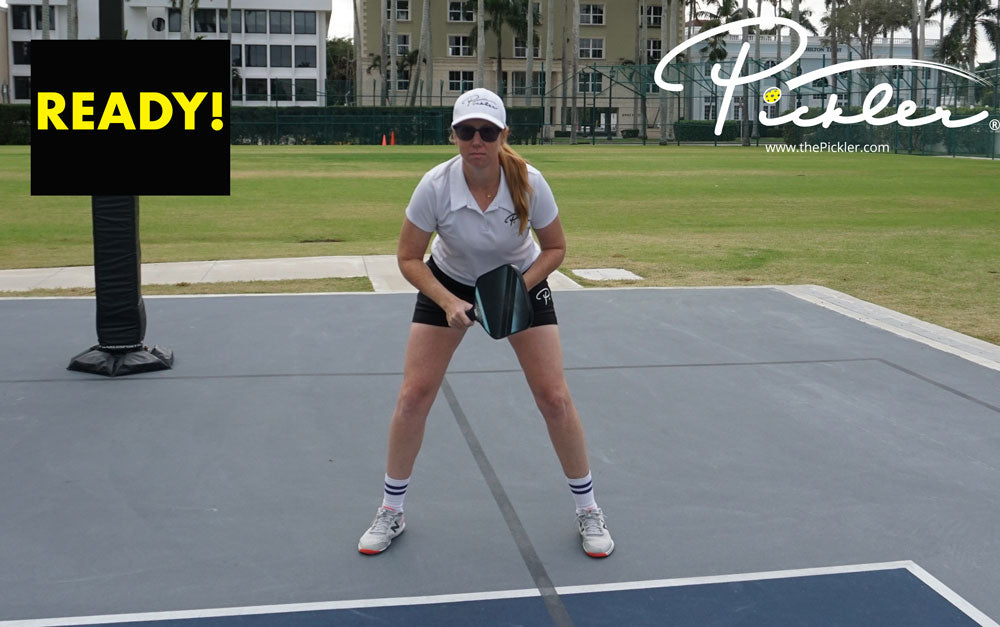
To help indicate that you are “not ready” for the score to be called or to prevent the quick server from serving the pickleball before you are ready, either (1) raise your pickleball paddle, or non-paddle hand, above your head, or (2) completely turn your back to the net. However, be aware that any “not ready” signals will be ignored if they are triggered after the start of the score being called. Also, be aware that “not ready” signals cannot be used to delay the game.
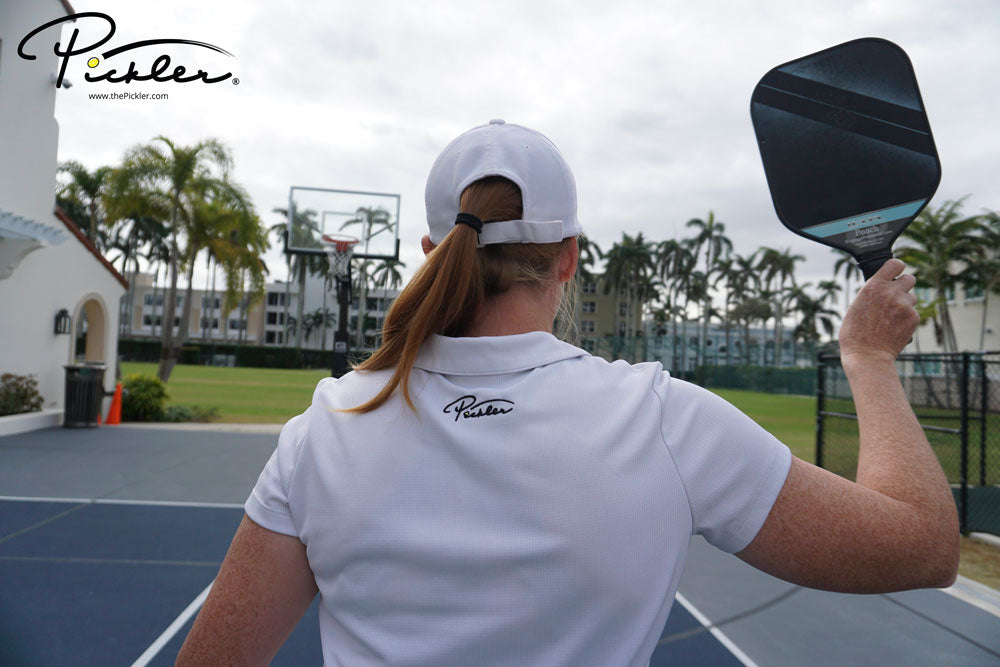
If the quick server intentionally continues to quick serve you – especially in violation of the rules, whether by committing a fault or intentionally serving while you have signaled that you are “not ready” – then:
- For recreational settings, either (a) up your own readiness and anticipate the serve immediately when the server touches the pickleball, or (b) avoid situations where you are on the pickleball court with the quick server.
- For tournament or other organized competition settings, either (a) up your own readiness and anticipate the serve immediately when the server touches the pickleball, or (b) consider requesting a referee or the tournament director/organizer to help resolve the dispute.
Beware, however, that a server can, without committing a fault, serve the pickleball quickly if he or she waits until you are ready, calls (or allows the referee to call) the score completely, and then quickly makes contact with the pickleball for the serve.
Pickleball Rules on Service Faults
A fault on the pickleball court is a violation of the rules that stops play and causes the team or player that committed the fault to lose the rally. Faults can be committed on the serve in pickleball. The Official Rulebook for pickleball provides that the following actions will result in a fault on the serving team and the applicable server will lose his or her serve:
- The server commits a service foot fault. Service foot faults are measured at the moment in time when the server’s paddle makes contact with the pickleball. A service foot fault will occur if, at the point of contact on the serve:
- At least one foot is not in contact with the ground behind the baseline;
- Any foot touches the baseline or any area inside of the baseline; or
- Any foot touches the area on or outside of the imaginary extension lines of the applicable sideline or centerline.


- The server serves from the wrong serving area.
- The incorrect player on the serving team serves the pickleball (to note, this is a common mistake when a doubles pickleball team is stacking).
- The server uses an illegal serving motion.

- The served pickleball lands anywhere outside of the proper service court. This is regardless of whether or not the pickleball touches the net or net cord (there are no service lets in pickleball). The proper service court includes the baseline, sideline, and centerline, but does not include the Non-Volley Zone or the Non-Volley Zone line. As a result, if the served pickleball lands in the Non-Volley Zone, or on the Non-Volley Zone line, then the server will have committed a fault.

- The server strikes the pickleball for the serve before the entire score (all three score numbers, such as 0-0-2, in doubles pickleball) is called.
- The served pickleball touches any permanent object (other than the net) before hitting the ground.
- The served pickleball touches the server (or his or her partner) and anything that the server (or his or her partner) is wearing or holding.
- After the server’s paddle makes contact with the pickleball for the serve, the server (or his or her partner) either calls a timeout or asks the referee to confirm the score. In other words, once the pickleball has been served, neither the server (or his or her partner) may call timeout or ask the referee to confirm the score.
No Service Lets in Pickleball
If a served pickleball touches the net, tape, cord, strap, or band of the pickleball net, and then lands in the correct service court, play will continue. There are no service lets in pickleball (in other words, there is no replay of the serve when the pickleball touches the net and lands in the correct service court). However, if the served pickleball touches the net, tape, cord, strap, or band of the pickleball net, and then lands outside of the correct service court (for instance, in the Non-Volley Zone, on the Non-Volley Zone line, or outside of the baseline, sideline, or centerline), then a service fault would have occurred.
In the past, there were service lets in the sport of pickleball. However, this rule has been changed to remove service lets in an effort to:
- preserve the integrity of the sport and prevent receiving teams from calling “phantom lets” on “ace serves”;
- reduce conflicts between players or between referees and players over a let call; and
- stop referees from performing a referee technique that some players found distracting, which was holding the pickleball net on the serve to detect lets and then stepping back out of bounds.
Pickleball Rules on Receiving Faults
A fault on the pickleball court is a violation of the rules that stops play and causes the team or player that committed the fault to lose the rally. Faults can be committed by the receiving team during the return of serve on the pickleball court. The Official Rulebook for pickleball provides that the following actions will result in a fault on the receiving team, which will result in a point for the serving team:
- The incorrect player on the receiving team hits the pickleball (to note, this is a common mistake when a doubles pickleball team is stacking).
- The receiving player (or his or her partner), intentionally or unintentionally, touches the pickleball, or interferes with the flight of the pickleball, before it bounces. For instance, a receiving fault would occur if the server intentionally serves the pickleball to hit the opposing player near the pickleball net (this move is commonly referred to as a “Nasty Nelson”). Or, the served pickleball sails long and hits the receiving player beyond the baseline before bouncing – this would be a receiving fault, even though the serve would have bounced out of bounds.
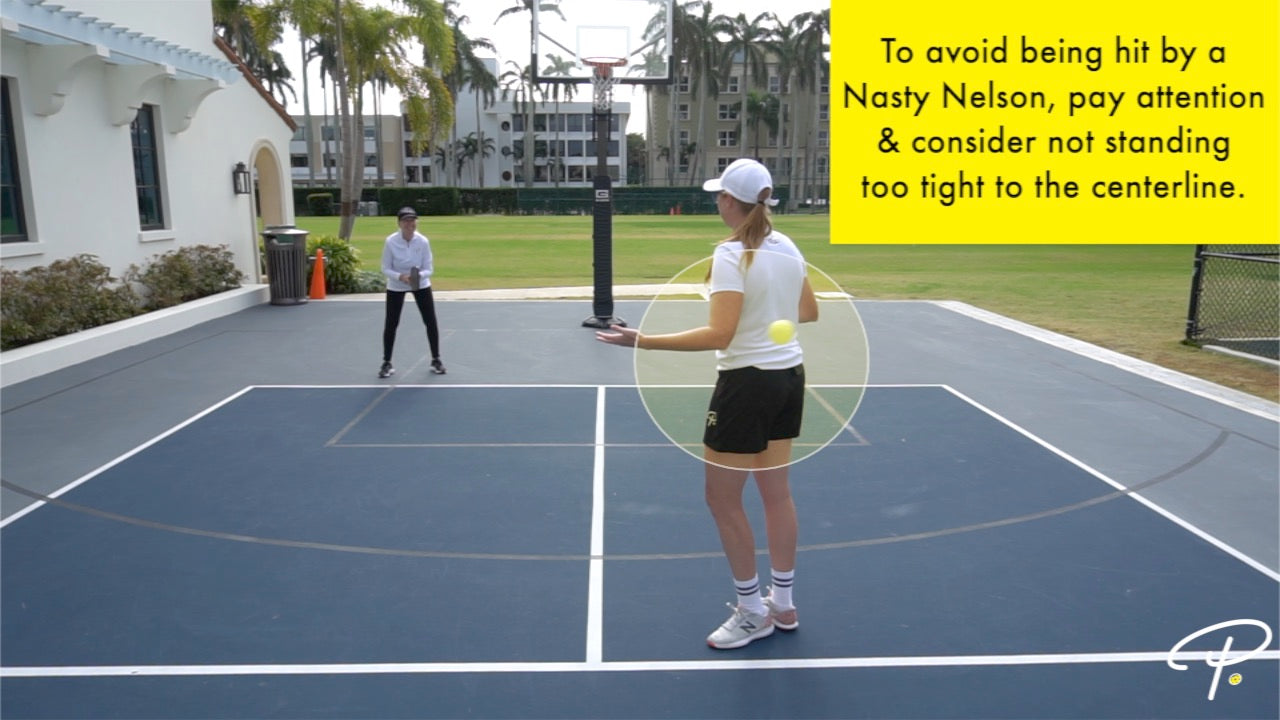
- After the server’s paddle makes contact with the pickleball for the serve, the receiving player (or his or her partner) either calls a timeout or asks the referee to confirm the score. In other words, once the pickleball has been served, neither the receiving player (or his or her partner) may call timeout or ask the referee to confirm the score.
What Is a “Nasty Nelson”?
Have you heard of the phrase “Nasty Nelson” on the pickleball courts? If not, a “Nasty Nelson” is certainly a shot to learn about. Although, be warned, that a Nasty Nelson can spark some controversy on the pickleball courts.
A Nasty Nelson is a shot on the pickleball courts where the server serves the pickleball to intentionally hit the opposing player nearest to the pickleball net (in other words, the opposing player that is not receiving the serve). If the served pickleball strikes the opposing player before it bounces, then the receiving team commits a fault, and the serving team wins the point. A Nasty Nelson is easiest to successfully execute if the opposing player nearest the pickleball net is close to the centerline of the pickleball court and/or not paying attention to the server.
This shot – Nasty Nelson – is named after Tim “The Puppet Master” Nelson. Tim Nelson is a top pickleball player that is known for his controversial style of play, which includes Nasty Nelsons (of course) and a puppeteer hand motion to celebrate getting the better of his opponents on any given shot.
To avoid being the victim of a Nasty Nelson, always pay attention and be ready as the receiving team player closest to the pickleball net. If you happen to be caught off guard one day, shake it off – it happens to the best of us.
Tips and Strategy for Pickleball Serves
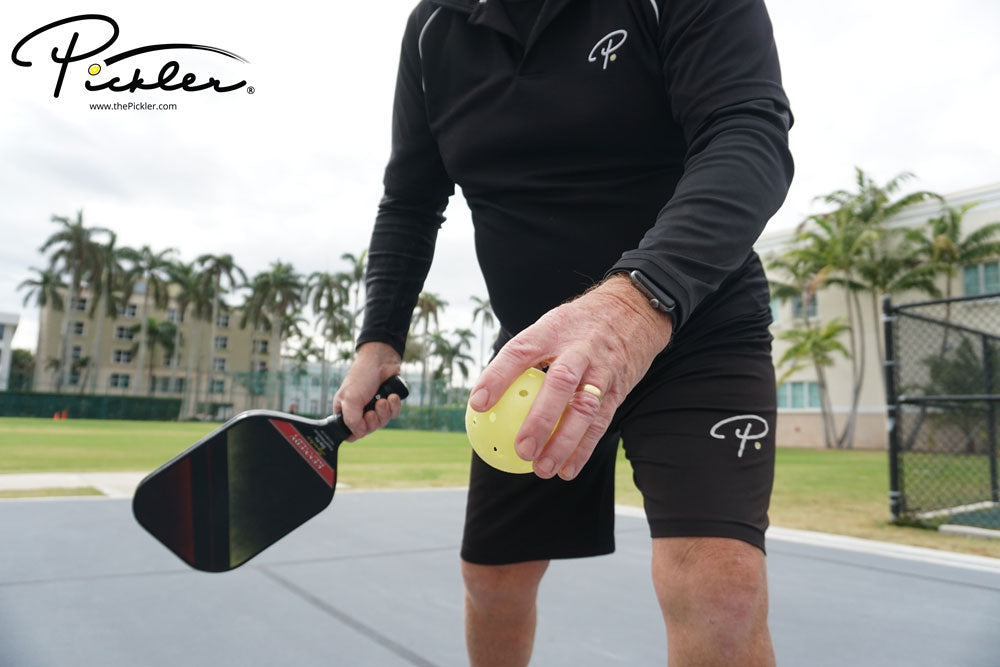
Now that you have mastered the pickleball serving rules, check our Pickler’s 7 pro pickleball serving tips to take your pickleball serve to the next level, which include key pickleball serve technique tips and key pickleball serving strategy tips!
Also, if you want more tips, strategies, and in-depth coaching to really master your serve, check out Pickler’s online video lesson collection called My Pro Pickleball Coach. My Pro Pickleball Coach is a fraction of the price of one clinic or even one lesson, and features over 140 video lessons (over 7 hours of instruction!), as well as a corresponding e-book. These online video lessons are available on demand 24/7 and breakdown every aspect of the sport of pickleball, including pickleball drills, strategy, and advanced concepts like lob serves, top spin serves, inside out serves, placement of serves, and other pickleball serve strategies.
Looking for More Pickleball Rules?
We know pickleball rules can be tricky at times. Don’t worry. Pickler explains the ins and outs of all of the pickleball rules in a series of pickleball rules blogs to make sure that you make the right call on the pickleball court. Learn more by visiting Pickler’s pickleball rules blogs that are linked below!
- Pickleball Rules – The Ultimate Guide to the Rules of Pickleball
- 10 Must Know Pickleball Rules Before Your Hit the Court
- 10 Pickleball Rules Changes to Learn for 2021
- Pickleball Rules – Learn How to Start – 5 Things You Need to Play
- Pickleball Dictionary – Quickly Learn the Pickleball Vocabulary
- Pickleball Serving Rules – Master the Start of Every Pickleball Game
- Pickleball Scoring Rules – Learn How to Keep the Score in Pickleball
- Pickleball Kitchen Rules – Learn Important Non-Volley Zone Rules
- Pickleball Line Call Rules – How to Make the Right Call
- Pickleball Rules – Faults & Dead Balls on the Pickleball Court
- Pickleball Rules – Commonly Misunderstood Rules in Pickleball
- Pickleball Tournament Rules – Must Read Before a Tournament
- Singles Pickleball Rules – How to Play Singles Pickleball
- Wheelchair Pickleball Rules – How to Play Wheelchair Pickleball

